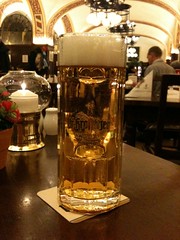Photo by: http://weblog.ch/
Grains:
4 lbs. Pilsner Malt
4 lbs. Munich Light
Hopping Schedule:
.75 oz. Perle, 9% alpha, 60 min.
.75 oz. Tettnanger, 3.80% alpha, 40 min.
.75 oz. Hallertau Tradition, 5.80% alpha, 40 min.
.50 oz. Tettnanger, 3.80% alpha, 10 min.
.50 oz. Hallertau Tradition, 5.80% alpha, 10 min.
Technical Specifications:
OG: 1.040 - 1.047
FG: 1.007 - 1.012
Alcohol: 4.6-5.3% by volume
Yeast: Wyeast Bavarian (W2206)
Protein Rest: 122°F
Conversion Rest: 155°F
Mashing Procedure:
Add approximately two gallons of water at 129°F to the grains to hit the first strike temperature of 122°F. Hold for 15 minutes. At the end of this time, draw off about 40 percent of the mash into a separate pot, leaving as much liquid behind as possible.
While maintaining the temperature in the main mash at about 122°F, raise the temperature of the decoction mash by about 5°F per minute to 155°F, stirring constantly. The mash you moved to the decoction pot was fairly thick and dry, but there is water bound up by the starch that will be released when heated. If it is still a little dry, add additional water to make stirring easier and to help avoid scorching the grain on the bottom of the pot.
Hold the decoction mash at this temperature for five minutes, then again raise its temperature by about 5°F per minute until boiling, stirring constantly. Once the mash is boiling constant stirring is not as necessary, but stir it occasionally to make sure the entire mash is cooked thoroughly. Boil for about five minutes.
At the end of this time, remove the decoction mash from the heat. Begin adding it back to the main mash a few cups at a time, stirring thoroughly between additions to distribute the heat uniformly. When about three-quarters of the decoction mash has been added back, begin monitoring the temperature. When it reaches 155°F, discontinue adding the decoction mash back to the main mash. Set the remainder aside until it cools to about 155°F, and then add it back to the mash.
Test for conversion with iodine by placing several drops of the mash, with no visible particles of grain or husk, in a small puddle on a white porcelain dish (Corning Corelle works well and doesn’t stain) and letting it cool. Then, placing a drop of iodine into the middle of the puddle, observe any color reaction along the edge of the iodine. If you observe the colors blue or black, then there’s still starch in suspension and the mash needs to continue. However, if brown appears or there is no color change, then it’s safe to prepare for sparging.
If you’re not using a combination mash/lauter tun, transfer the mash to the lauter tun. In either case thoroughly stir the mash and let it settle for 10 minutes before initiating the sparge. Collect seven gallons of wort. You can be testing the specific gravity and tasting the sweet wort. Discontinue the sparge when the specific gravity of the runoff drops below about 1.010 or the taste reminds you of warm tea (an indication that tannins are being extracted from the husks). If this happens before you’ve collected the entire seven gallons of wort, just use plain water to make up the difference.
Boil the wort for a total of 90 minutes, adding hops per the schedule indicated. Before beginning to chill the wort, reserve two quarts of wort for later use in priming the beer. You can use sanitized mason jars for this purpose, which you’ll then store in the refrigerator.
Chill the remaining wort to about 70°F and then pitch the yeast. Transfer the fermenter to a 45°F refrigerator for three to four hours after pitching and ferment for seven to 10 days, then transfer to a secondary fermenter.
When the beer is clear (about two to three weeks), rack it to the bottling bucket into which the reserved priming wort has been poured. Bottle as usual.
Source: BYO
Have New Posts From Beer Recipes Delivered To Your Email
Subscribe to:
Post Comments (Atom)







0 comments
Post a Comment